-

人教版高中英语必修1Nelson Mandela--A Modern Hero说课稿
In this step, give students a few minutes to read the passage . While they are reading, I will write some key words of the text on the blackboard. Then ask students to retell the passage according to the key words.By retelling, students can improve their ability of language organization and have an overall understanding of the article.Step 4 Group discussionIn this step, students will be divided into groups of 4 to discussion the following question: What qualities make a great person?After their discussion, invite a few groups to make a report to the class.This group discussion can practice students’ oral English and cultivate their abilities of cooperation and communication.Step 5. HomeworkLet students write a short passage to introduce a great person he or she admires.The homework can consolidate the knowledge the students have learned and cultivate their writing ability. Part 6 Blackboard Design(板书设计)That’s all my teaching procedures. Finally, I’d like to say sth about part 6 blackboard design. On the top is the title. On the left, there will be some new words and expressions. In the middle of the blackboard, I will write some useful sentence structures so that the students can know clearly what they’ve learned and then try to master the knowledge.OK. That’s all for my presentation. Thank you for your attention.

人教版高中英语必修2Computers说课稿3篇
一. 教材分析1. 本单元的中心话题是“计算机(Computers)”,内容涉及计算机的发展历史,计算机的应用等。本节课是该单元的第一课时,我将Warming up, Pre-reading and Comprehending这四部分整合为一节精读课。其中。Reading部分是题为WHO AM I?的文章,以第一人称的拟人手法介绍了计算机发长演变的历史和计算机在各个领域的应用,其主旨是表达计算机的发展变化之快以及在生活中用途之广。而Warming up部分以图片的形式展现了计算机的发展历程;Pre-reading中的问题和排序分别是为了预测语篇的内容和测试学生对计算机历史了解的情况;Comprehending则通过各项练习训练学生的阅读技能,从而加深对文章的理解。可见这几部分是一个有机的整体。2. 教学目标:1) 语言目标:重点词汇及短语:abacus, calculate, calculator, PC, laptop, PDA, robot, analytical, technological, universal, mathematical, artificial, intelligent, network, explore, in common, as a result.重点句子:a. My real father was Alan Turing, who in 1963 wrote a book to describe how computers could be made to work, and build a “universal machine” to solve any mathematical problem.

人教版高中英语必修4A taste of English Humor说课稿3篇
Then I would ask them to think of a funny English or Chinese and tell it to partners. While telling stories, they can use expressions and some acting to help make the story funny. 5 minutes would be given to do this.Those stories they told there will be the material for their writing. Soletting them tell it at first is helpful. And they can make a difference between telling a funny story and writing it down. Generally speaking, it is difficult forstudents to write well because they don’t know what to write and how to write. Asking them to tell their own stories at first can help them come up with what to write.After their telling, I would invite someone to share his/her story with all of us and I would write it down on the blackboard.This example story would be used as a sample to illustrate the format of funny story. Different from a story from teacher or textbook, a story from students can obviously become a interesting material to draw students’ attention.Then I would ask the whole class to put this story into several parts. It might be a little bit difficult for them. So I would ask them to find out whether all the sentences are necessary. After delete some sentences, there are 6 sentences left behind. Then they can easily put them into three parts. After interaction with students, I would teach them the right terms for each part and conclude the format of funny story.This step is the key and difficult point in my lesson. So I mainly usetask-based teaching method in this part and the task for students was divided into several stages. With the separated difficult level, students can find there are usually three parts in writing. They can also learn to write without the unnecessary parts in the process of analyzing. And then I wouldn’t rush to tell them the right terms to them directly. Instead, I would ask them to name them by their own. A confused mind is better for acquiring knowledge.While-writing:Then I would give students 7 minutes to write down this story, without other requirements.With all the preparations in pre-writing, students’ difficulties were cleared. So it would be much easier for them to write down the story within 7 minutes. There are no other requirements because students’ first writing is actually a drafting. It would be revise and edit several times later. Writing, as a skill

人教版高中英语必修3Canada-the true north说课稿4篇
Good afternoon, teachers, It’s my great pleasure to be here sharing my lesson with you.The content of my lesson is Senior English Book 3 Unit 5 Canada —— “The true North”.I’ll be ready to begin this lesson from five parts. Analysis of the teaching material,the teaching methods,the studying methods, the teaching procedure,and Blackboard design.First, let me talk about the teaching material.Part 1 Teaching Material:This unit is about the introduction of Canada. By studying of this unit,we’ll enable the students to learn the geography, population, main cities, and natural beauty, natural resources of Canada. Through the training of the unit, it also requires students to learn some Language skills such as the expressions of position and emotions.So it plays an important part in the English teaching in this book.After studying the teaching material and analyzing the rule of children’s growing of mind,I think the teaching aims are the followings:1.Knowledge objects:(1) make the students learn some new words and phrases(2) make the students understand the content of the lesson.2.Ability objects:(1)To develop the Ss’ abilities of listening, speaking, reading and writing. Especially reading and speaking ability.(2) learn to talk about the characters of Canada in English(3)To train the Ss’ ability of working in pairs.3.Emotion objects:(1)Enable students to understand the characters of Canada..(2)Stimulate Ss to work hard to make China stronger.Part 2 Teaching Methods:I think helping students learn to master new words and phrases and improve the students’ reading and speaking ability is import and the difficult.According to the analysis of the teaching material and the import points and the difficult points,I will use the following teaching methods : question-guiding approach; fast-reading and careful reading; multi-media teaching methods; discussion

人教版高中英语必修4Working The Land说课稿3篇
Knowledge objectives:(1) to make Ss grasp the usage of words, expressions and sentence structures: statistics, struggle, thanks to, rid of, some patterns for persuasion, the “ing” form as subject and object;(2)to use learnt knowledge to persuade sb.Ability objectives:(1) to develop Ss’ reading skills(skimming, scanning, word guessing);(2) to improve Ss’ speaking, communicating and cooperating skills.Emotional objectives:to make Ss know the contribution of Yuan,and learn his spirit and his simple life time.Teaching important and difficult points:(1) some words, expressions and sentence structures mentioned above;(2)the content of the text;(3)training their reading and speaking skills.Teaching methods: CLT, TBLT,QT.Learning strategies: CLS, QLS, TBLS.Teaching procedures:Step 1 lead-in: (1) teacher plays a piece of recent news from CCTV about the harvest of the super hybrid rice, and ask students whether they know Yuan or not, and talk about him and his contribution.(2)Brain storm: let Ss describe Yuan in their minds including his appearance, his living condition and so on.Step 2 fast reading tasks:(1)teacher introduces Yuan and super hybrid rice(2)make Ss read the text as fast as possible with questions. Such as: what’s the general ideaof this passage? What’s Yuan’ dream? (skimming and scanning skill)Step 3 intensive reading tasks(1)let Ss read the text silently, find topic sentence of each paragraph and draw the difficult sentences and the knowledge what they don’t understand.(words guessing)(2)teacher and Ss talk about the important words, expressions and sentences together, and ask Ss to retell the content of the text.(summarizing and paraphrasing)(3)teacher summarize this part.(4) read again following the courseware.

人教版高中英语必修3The million pound bank note说课稿3篇
在接下来的细读环节,我套用了高考对阅读理解的考查方式设置了5个问题,分别为三个推理判断题,一个细节题和一个主旨大意题。学生需要对文章的内容进行分析、归纳、推理、猜测等高级思维活动才能做出正确的回答。【设计意图】这一过程是对学生进行细读的训练,培养学生获取特定信息和挖掘文章深层次信息的能力。第三环节:Intensive-reading (精读) 15′第三个环节精读,既是最重要的环节,也是突破本课重难点的关键。首先,让学生思考剧本中人物看到百万英镑前后的态度发生了怎样的变化。其次,让学生仔细阅读文章,找出可以表现人物态度变化的具体的语言和动作。最后,让学生总结人物的态度发生变化的根本原因是什么,从而引出Money Talks, 供学生思考。【设计意图】通过一系列的活动培养学生学习从人物的语言和动作探究人物的心理,使学生进一步体会戏剧语言的魅力,从而对文章背后所反映的社会问题进行思考,也为下一步的讨论环节做好铺垫。

人教版高中英语必修5The United Kingdom说课稿4篇
Teaching Aims:Knowledge 1. Get the students to learn the useful new words and expressions in this section. Aims:2. Let the students learn about how the UK was formed and the four groups of invaders.1. Develop students’ reading ability and let them learn different Ability reading skills. Aims:2. Enable students to learn to talk about the United Kingdom and the Union Jack Emotional 1. Let students know more about the UK2. Develop students’ sense of cooperative learning Aims:Teaching Important Points:1. Let the students learn about the countries of the United Kingdom and the Union Jack2. Get the students to read the passage and know about how the UK was formed and the four groups of invaders.3. Have the students learn different reading skills.Teaching Difficult Ponts:1. Develop students’ reading ability.2. Enable students to talk about the United Kingdom and the Union Jack.3. Let students learn how the UK was formed geographically and historically.Teaching Methods:Showing pictures, asking, exercising, listening, reading etc.Teaching Aids:A computer,a projector and a blackboard.Teaching Procedures: 1) Show a map of the world, ask students the following questions:Where is the UK?What’s the full name of the UK?2) Ask the students work in pairs to do the quiz on Page 9.Do you want to test how many things you know about the United Kingdom? Let’s have a small test.Using the map on P9, students answer the following questions:?How many countries does the UK consist of? What are they??England is divided into three main areas. Do you know what they are? 1) Scanning (10Minutes )Let the students hold the questions asked in pre-reading and read the passagequickly and then let them do the following exercise.Join lines to the right answer.
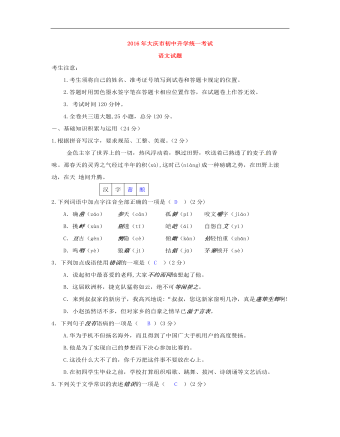
黑龙江省大庆市2016年中考语文试题(word版,答案不全)
秦王谓唐雎曰:“寡人以五百里之地易安陵,安陵君不听寡人,何也?且秦灭韩亡魏,而君以五十里之地存者,以君为长者,故不错意也。今吾以十倍之地,请广于君,而君逆寡人者,轻寡人与?”唐雎对曰:“否,非若是也。安陵君受地于先王而守之,虽千里不敢易也,岂直五百里哉?”
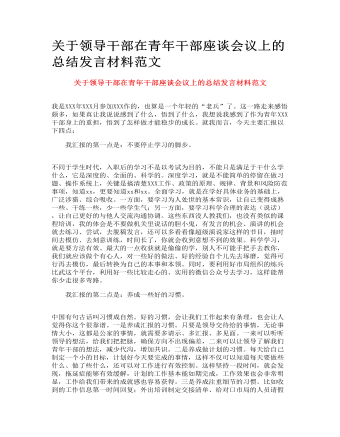
关于领导干部在青年干部座谈会议上的总结发言材料范文
中国有句古话叫习惯成自然。好的习惯,会让我们工作起来有条理,也会让人觉得你这个很靠谱。一是养成汇报的习惯。只要是领导交待给的事情,无论事情大小,这都是公家的事情,就需要多请示、多汇报、多见面。一来可以听听领导的想法,给我们把把脉,确保方向不出现偏差,二来可以让领导了解我们青年干部的想法,减少代沟,增加共识。二是养成做计划的习惯。每天给自己制定一个小的目标,计划好今天要完成的事情,这样不仅可以知道每天要做些什么、做了些什么,还可以对工作进行有效控制。这样坚持一段时间,就会发现,拖延症能够有效缓解,计划的工作基本能如期完成,工作效果也会非常明显,工作给我们带来的成就感也容易获得。三是养成注重细节的习惯。比如收到的工作信息第一时间回复;外出培训制定交接清单、给对口市局的人员请假;打电话等对方挂了之后自己再挂等等。这些都是细节方面的问题,但往往细节决定成败,需要我们在工作中多加留心、多加注意。
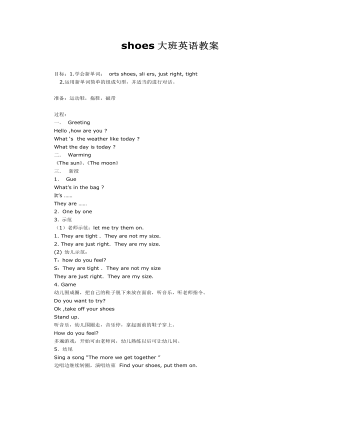
大班英语教案:shoes大班英语教案
过程: 一. Greeting Hello ,how are you ? What ‘s the weather like today ? What the day is today ? 二. Warming 《The sun》、《The moon》 三. 新授 1. Gue What’s in the bag ? It’s …… They are …… 2.One by one
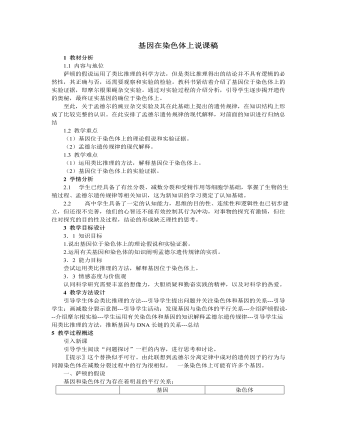
人教版高中生物必修2基因在染色体上说课稿
三、孟德尔遗传规律的现代解释①分离定律:在杂合体的细胞中,位于一对同源染色体上的等位基因,具有一定的独立性;在减数分裂形成配子的过程中,等位基因随同源染色体的分开而分离,独立地随配子遗传给后代。②自由组合定律:位于非同源染色体上的非等位基因的分离或组合是互不干扰的;在减数分裂过程中,同源染色体的等位基因彼此分离的同时,非同源染色体上的非等位基因自由组合。总结:再次强调孟德尔遗传定律的现代解释课堂练习:书本31页6、教学反思:本节课设置了一系列问题情境,层层设问,在学生答问、质疑、讨论过程中让学生建构新概念和新的知识体系,并通过教师及时掌握反馈信息,适时点拨、调节,让学生在推理判断中培养良好的思维习惯和对知识的迁移能力,而且通过留出一定的时间让学生提问,体现了以学生为主体的思想。
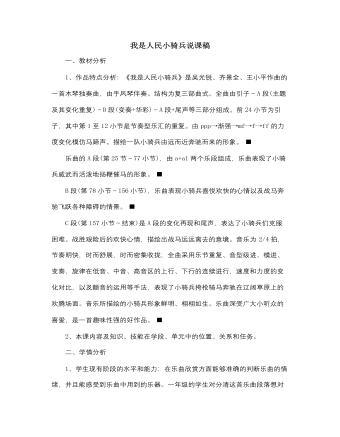
人音版小学音乐二年级下册我是人民小骑兵说课稿
教师与学生有导有游,避免了以往欣赏课教学中枯燥的让学生完整听,分段听,机械式的讨论欣赏,增加了情趣,用不同的音乐活动表现不同的段落,让学生清晰各个段落的旋律与表现内容。2、本课成功之处:创设良好的学习情境,营造良好的学习氛围。学生在学习过程中,通过舞蹈、器乐伴奏等表演感受到了音乐段落的变化,学生清楚的分清段落层次。3、本课失败之处:舞蹈动作的创编如果能更加生动,体现出小骑兵的神气活现会更好。4、生成问题:学生在合作表演时,打击乐器的节奏容易不稳,教师提醒学生注意的同时可以带领学生一起敲击控制好节拍。最后为了丰富学生对音乐的体验,我在这一部分让学生通过欣赏歌曲《草原英雄小姐妹》,感受蒙古音乐的节奏特点,体验并升华情感。5、今后调整思路:舞蹈动作可以创编更生动更有表现力的动作,丰富学生的感受和表现力。
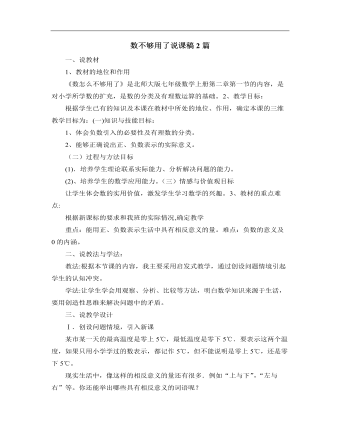
北师大版初中八年级数学上册数不够用了说课稿2篇
(3)在某乒乓球质量检测中,一只乒乓球超出标准质量0.02克,记作+0.02克,那么-0.03克表示什么?解:(1)扣20分,记作-20分;(2)沿顺时针方向转12圈记作-12圈;(3)-0.03克表示乒乓球的质量低于标准质量0.03克。4、让学生回顾现已学过的数,将他们进行分类,最后教师总结。(三)课堂练习,及时反馈为了让更多的学生参与进来,通过练习巩固知识发现不足,教师及时得到反馈,检查教学效果,采取相应措施,我采用了一下习题:(电脑演示)在练习过程中培养学生养成用所学知识去思考问题、判断问题、解决问题的好习惯。学生的练习分出了梯度,让不同学生的学生都有所提高,有助于贯彻因材施教的教学原则。各组练习在进行中,进行后,都要掌握学生的完成情况,让学生举手,加以统计,及时纠错及再讲解。在学生回答问题时,我通过语言、目光、动作给予鼓励与告诉,发挥评价的增益效应。
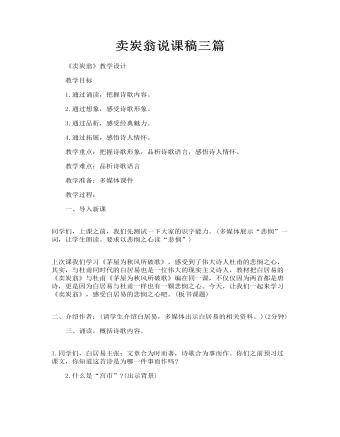
卖炭翁说课稿三篇
一、导入新课 同学们,上课之前,我们先测试一下大家的识字能力。(多媒体展示“悲悯”一词,让学生朗读。要求以悲悯之心读“悲悯”) 上次课我们学习《茅屋为秋风所破歌》,感受到了伟大诗人杜甫的悲悯之心,其实,与杜甫同时代的白居易也是一位伟大的现实主义诗人,教材把白居易的《卖炭翁》与杜甫《茅屋为秋风所破歌》编在同一课,不仅仅因为两首都是唐诗,更是因为白居易与杜甫一样也有一颗悲悯之心。今天,让我们一起来学习《卖炭翁》,感受白居易的悲悯之心吧。(板书课题) 二、介绍作者:(请学生介绍白居易,多媒体出示白居易的相关资料。)(2分钟) 三、诵读,概括诗歌内容。 1.同学们,白居易主张:文章合为时而著,诗歌合为事而作。你们之前预习过课文,你知道这首诗是为哪一件事而作吗? 2.什么是“宫市”?(出示背景) 时宦者主中市买,谓之“市”,抑买人物,稍不如本估(压低人家的物价,比原价稍低)。末年(唐德宗贞元末年)不复行文书,置“白望”数十百人于两市及要闹坊曲,阅人所卖物,但称“市”,则敛手付与,真伪不复可辨,无敢问所从来及论价之高下者。率用值百钱物,买人值数千物,仍索门户及脚价银。人将物诣市,至有空手而回者。名为“市”,其实夺之。《旧唐书张建封传》 3.试想一下白居易写这事时心情怎样?
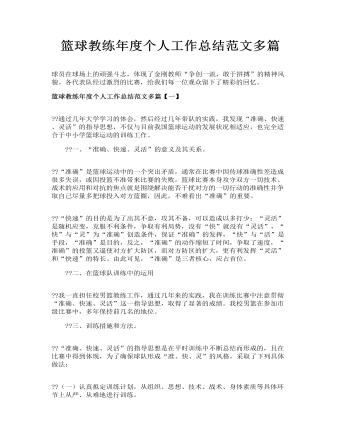
篮球教练年度个人工作总结范文多篇
一、“准确、快速、灵活”的意义及其关系。 “准确”是篮球运动中的一个突出矛盾,通常在比赛中因传球准确性差造成很多失误,或因投篮不准带来比赛的失败。篮球比赛本身攻守双方一切技术、战术的应用和对抗的焦点就是围绕解决能否干扰对方的一切行动的准确性并争取自己尽量多把球投入对方篮圈,因此,不难看出“准确”的重要。 快速”的目的是为了出其不意,攻其不备,可以造成以多打少;“灵活”是随机应变,克服不利条件,争取有利局势,没有“快”就没有“灵活”,“快”与“灵”为“准确”创造条件,保证“准确”的发挥,“快”与“活”是手段,“准确”是目的,反之,“准确”的动作缩短了时间,争取了速度,“准确”的投篮又逼使对方扩大防区,而对方防区的扩大,更有利发挥“灵活”和“快速”的特长。由此可见,“准确”是三者核心,应占首位。 二、在篮球队训练中的运用 我一直担任校男篮教练工作,通过几年来的实践,我在训练比赛中注意贯彻“准确、快速、灵活”这一指导思想,取得了显著的成绩。我校男篮在参加市级比赛中,多年保持前几名的地位。
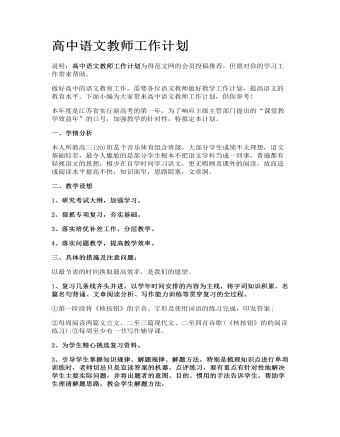
高中语文教师工作计划
二、教学设想1、研究考试大纲,加强学习。2、狠抓专项复习,夯实基础。3、落实培优补差工作,分层教学。4、落实问题教学,提高教学效率。
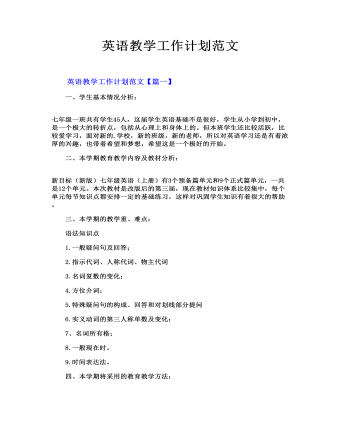
英语教学工作计划范文
1.用英语教英语(Teach English inEnglish); 英语毕竟是一门语言,训练的是学生的听、说、读、写、译的综合能力,在教学的过程中需要对学生的听、说、读、写、译的能力进行很多的训练,这就要求我们用英语来教英语,在课堂上对学生进行各种能力的训练。
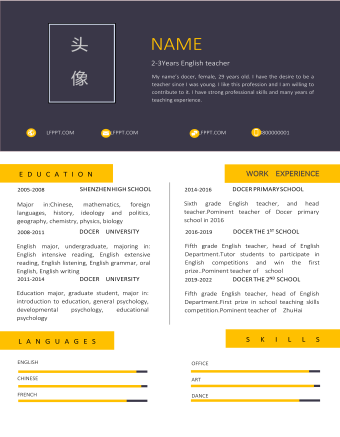
蓝黄色英语教师英文简历
Major in:Chinese, mathematics,foreign languages, history, ideology and politics, geography, chemistry,physics, biologyEnglishmajor, undergraduate, majoring in: English intensive reading, English extensivereading, English listening, English grammar, oral English, English writingEducationmajor, graduate student, major in: introduction to education, generalpsychology, developmental psychology, educational psychology
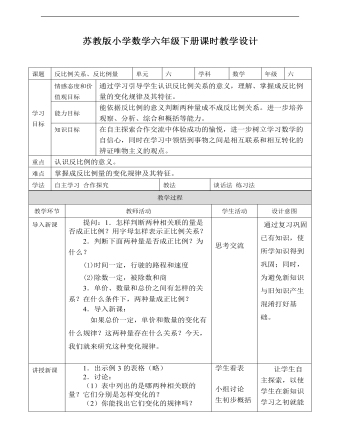
小学数学苏教版六年级下册《第六单元第三课反比例关系、反比例量》教学设计说课稿
提问:1.怎样判断两种相关联的量是否成正比例?用字母怎样表示正比例关系? 2.判断下面两种量是否成正比例?为什么? (1)时间一定,行驶的路程和速度 (2)除数一定,被除数和商 3.单价、数量和总价之间有怎样的关系?在什么条件下,两种量成正比例? 4.导入新课: 如果总价一定,单价和数量的变化有什么规律?这两种量存在什么关系?今天,我们就来研究这种变化规律。
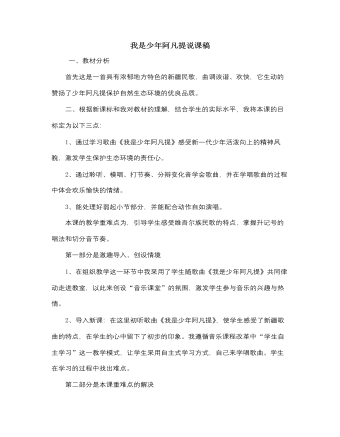
人音版小学音乐四年级下册我是少年阿凡提说课稿
紧接着是升记号的认识。在这里我把升记号介绍给学生,教师先用电子琴演奏没有升记号的乐句,再演奏有升记号的乐句,学生听一听那一个音有变化。然后教师再分别把单独的有变化的一个音拿出来进行比较,最后用键盘图在幻灯片上展示。使学生更直观的去听去感受,使学生听觉与视觉互补。增强学生的参与意识,使复杂乏味枯燥的音乐知识变的趣味化,生动化,通过师生的共同参与,更加拉近了教师与学生的距离。最后是编创与活动.由于这首歌是以环保为主题,所以我用音乐与环境保护有机结合的融合,从而进行德育渗透,通过生生合作、和自主探究的方式来进行编创歌词。最后让学生用载歌载舞的形式表现歌曲.依托音乐本身的魅力培养学生主动学习,合作意识,探究精神,从目标的提出到过程的安排,学习方法的确定乃至学习成果的呈现,都让学生有更大的自主性,更多的实践性,更浓的创造性。

